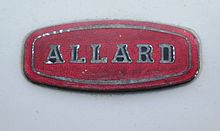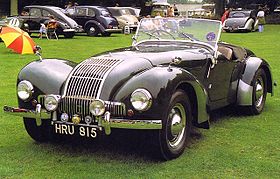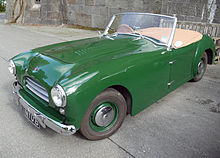
Allard



Allard Motor Company Limited was a London-based low volume car manufacturer founded in 1945 by Sydney Allard which commenced from small premises in south west London.
Car manufacture almost ceased within a decade It produced approximately 1900 cars before it became insolvent and ceased trading in 1958 Before the war, Allard supplied some replicas of a Bugatti-tailed special of his own design from Adlards Motors in Putney
Allards featured large American V8 engines in a light British chassis and body, giving a high power-to-weight ratio and foreshadowing the Sunbeam Tiger and AC Cobra of the early 1960s. Cobra designer Carroll Shelby and Chevrolet Corvette chief engineer Zora Arkus-Duntov both drove Allards in the early 1950s.
Pre-war Allard Specials
The first Allard cars were built specifically to compete in "trials" events – timed rally-like events on terrain almost impassable by wheeled vehicles. The first Allard was powered by a Ford flathead V8 in a body mostly sourced from a Bugatti racer. It used the American engine's high torque to great effect in slow-speed competition.
Further Allards were soon built to order with a variety of large, Ford-sourced engines, including Lincoln-Zephyr V12 powerplants. By the outbreak of war in 1939 twelve Allard Specials had been built. Sydney Allard's planned volume production was pre-empted by work on Ford-based trucks during the conflict. By its end, Allard had built up a substantial inventory of Ford parts.
Post-war models
Using its inventory of easy-to-service Ford mechanicals built up during World War II and bodywork of Allard's own design, three post-war models were introduced: the J, a competition sports car; the K, a slightly larger car intended for road use, and the four seater L. Sales were fairly brisk for a low-volume car, and demand was high for cars in general, which led to the introduction of several larger models, the drophead coupe M and P.
K1
| Allard K1 | |
|---|---|

1949 Allard K1
|
|
| Overview | |
| Production | 1946–1949 |
| Powertrain | |
| Engine | Ford Britain L-Head V8 Canadian Mercury L-Head V8 |
| Transmission | 3-speed manual |
| Dimensions | |
| Wheelbase | 2,690 mm (106.0 in) |
Built from 1946-1949, the K1 was Allard's first postwar car and was largely a carryover from the limited production prewar J1. The frame was made up from stamped-steel channel sections by Thomsons of Wolverton specially for Allard. Side rails and cross members were designed to fit the Ford suspension
L

The L is a 4-seater sports which was produced from 1946 to 1950. It was available with a choice of 3,622cc Ford V8 or 4,375cc Mercury engines. 191 examples were produced.
J2

Sydney Allard soon saw the potential of the economically more vibrant – but sports car starved – US market and developed a special competition model to tap it, the J2. The new roadster was a potent combination of a lightweight, hand-formed aluminium body fitted with independent front suspension and de Dion type rear axle, inboard rear brakes, and designed for a Ford "flathead" V8. Allard's distinctive front suspension was produced by splitting the I-beam front axle in two to make swing axles, with long radius rods and a new feature, for their day, of inclined telescopic shock absorbers. Importing American engines just to ship them back across the Atlantic proved problematic, so US-bound Allards were soon shipped engineless and fitted out in the States variously with newer overhead valve engines by Cadillac, Chrysler, Buick, and Oldsmobile. In that form, the J2 proved a highly competitive international race car for 1950, most frequently powered by 331-cubic-inch Cadillac engines. Domestic versions for England came equipped with Ford or Mercury flatheads. Russian-American engineer Zora Arkus-Duntov, formerly of Ardun (named after founders Yura and Zora ARkus-DUNtov) where he designed and developed aluminium overhead valve hemi heads for flathead Fords, worked for Allard from 1950 to 1952 and raced for the factory Allard team at Le Mans in 1952 and 1953.
Available both in street trim and stripped down for racing, the J2 proved successful in competition on both sides of the Atlantic, including a third place overall at Le Mans in 1950 (driven by Sydney Allard himself, who also placed first in the Monte Carlo Rally in 1952 driving an Allard P1 saloon car). Of 313 documented starts in major races in the 9 years between 1949 and 1957, J2's compiled a list of 40 first-place finishes; 32 seconds; 30 thirds; 25 fourths; and 10 fifth-place finishes. Both Zora Arkus-Duntov (the first chief engineer for the Chevrolet Corvette) and Carroll Shelby (the creator of the AC Cobra) raced J2s in the early 1950s. Ninety J2s were produced between 1950 and 1952.
In an effort to extend a line growing obsolete in the face of advances in sports car design, Allard introduced an 'improved' model in late 1951, the J2X (extended). The chassis remained unchanged from the previous J2 (Tom Lush, Allard the inside story) but in an attempt to improve handling, the front suspension's rear attaching radius rods were redesigned with forward ones, which required a forward cross member and extending the nose out past the front wheels. This, in turn, allowed the engine to be moved forward, yielding more cockpit room. There is often confusion when it comes to identification of J2 and J2X types because they are seemingly very similar. However, the most obvious differences are that the J2 nose does not extend past the front tyres and has two vents below the grille, while the J2X nose has a more protruding chin with a single vent below the grille, which, as explained extends out past the front tyres. Allard historian Tom Lush, who was Sydney Allard's Personal Assistant and Allard employee from the beginning, said in his definitive book "Allard: The Inside Story" that the chin was the most obvious difference between the two models. In standard form the spare wheel was carried hidden on top of the rear-mounted fuel tank, but either version could carry one or two side mounted optional spares. This allowed the use of a 40 gallon long distance fuel tank.
Arriving later, during a time when sports racing car design was developing rapidly, the J2X was not as successful in international racing as the J2, as it was not as competitive when compared to more advanced C and later D type Jaguars, alongside Mercedes, Ferrari, and Maserati works entries. Thus, it headlined less often in major international races and of 199 documented major race starts in the 9 years between 1952 and 1960, J2X's garnered 12 first-place finishes; 11 seconds; 17 thirds; 14 fourths; and 10 fifth places.
P1

Known more often than not simply as the Allard 3.6-litre Saloon, the P1 was a five-seat, two-door sports saloon produced between 1949 and 1952. The cars used Ford engines and transmissions, and included a "Sports" model. In 1952 an Allard P1, driven by Sydney Allard himself, along with Guy Warburton, won the Monte Carlo Rally. Tom Lush was the navigator.
The P1 was the choice of professionals who wanted something different and was quite popular with doctors and solicitors in its day. Some 559 were produced during the models run. Today it is believed than less than 45 remain worldwide. Sir Greg Knight MP, the current chair of the All-Party Parliamentary Historic Vehicles Group owns a late 1952 P1.
M-Type

The M-Type was offered in 1948 and 1949 as a Drophead Coupé.
K2

The K2 is a 2-seater sports car produced from 1950 to 1952. It was offered with Ford and Mercury V8 engines in the home market and with Chrysler and Cadillac V8 engines in the USA. 119 were built.
Clipper

The 1953 Clipper was an attempt to cash in on the era's burgeoning microcar market. A tiny glass-fibre-bodied car powered by a rear-mounted 346 cc Villiers twin-cylinder motorcycle engine, it claimed to seat three people abreast with room for two children in an optional Dicky seat. About 20 were made.
Palm Beach

Allard introduced the 4- and 6-cylinder Palm Beach roadster in 1952. Built until 1958, the MkI was only available with four- or six- cylinder engines. A Mark II was introduced in 1956, it could be had with a six-cylinder 3.4-litre (3442 cc) Jaguar engine.
K3

Also in 1952, Allard adapted the Palm Beach in a K3, an attempt to offer a more civilized variant of the J2 and J2X models seen at the track. Exported to America as a potential "Corvette slayer" Dodge dealers had been clamoring for, it featured one of the most powerful engines of its era, the 331 cu. in. Chrysler hemi engine, fitted with a pair of 4-barrel carburetors. Essentially a rebodied Palm Beach, it failed to find a niche in either market in spite of its performance. Today the exceptionally rare automobile can fetch the better part of a quarter million dollars (US) at auction.
P2 Monte Carlo

The P2 Monte Carlo was a 2-door saloon variant of the K3, produced from 1952 to 1955. It utilised a wood frame with aluminium panels on a 112-inch wheelbase and was offered with 3.6-litre Ford Pilot V8 and 4.4-litre Mercury V8 engines. 11 were built.
P2 Safari

In an attempt to further extend its line, Allard adapted its P1 saloon to produce the 8-seater, wood-sided, V8-engined, P2 Safari Estate. It too found weak sales.
Decline and attempted revival
Insufficient research and development meant that Allard failed to keep up with cheaper and more technically advanced cars. The Palm Beach was essentially a year behind its competitors, the K3 failed to live up to expectations, and the Safari Estate could not find a market.
By the mid-1950s Allard was struggling to remain solvent. The market was weak due to a late-1950s US recession.
Sydney Allard's son, Alan Allard, marketed the Allardette 105, 109, and 116, using the straight-four-cylinder engine from the Ford Anglia and other Ford models.
In 1966 Sydney Allard died on the same night that an arsonist destroyed the Clapham factory and some of the Allard Motor Company factory records. The Allard factory site in Clapham is now a housing co-operative association, but the showroom and workshop in Putney remains as a car dealership.
In 2011, a new joint venture company was formed by Alan & Lloyd Allard, the son and grandson of Sydney Allard, with Chartered Surveyor, Jason Wharton, called Allard Motor Cars Limited. Its aim was to revive the long defunct marque, by building a series of Allard continuation cars to historic period motor racing specification. This was to be followed by the production of a new Allard Speedster sports car. This venture was aborted by the parties after a dispute arose over the ownership of the trademark, which had been bought by Allard Motor Cars Limited as Bona Vacantia. At a formal hearing of the Intellectual Property Office, Cardiff, it was ruled that the trademark owned by Allard Motor Cars Limited be revoked on grounds of its non-use.











